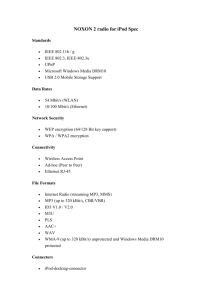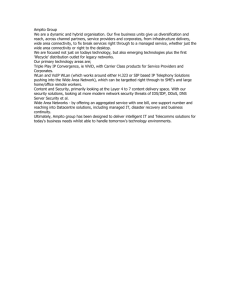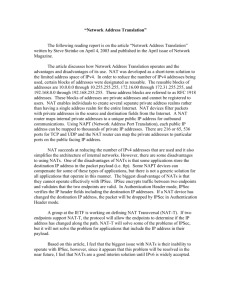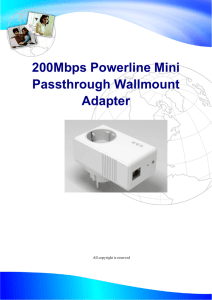Toshiba SureLink
advertisement
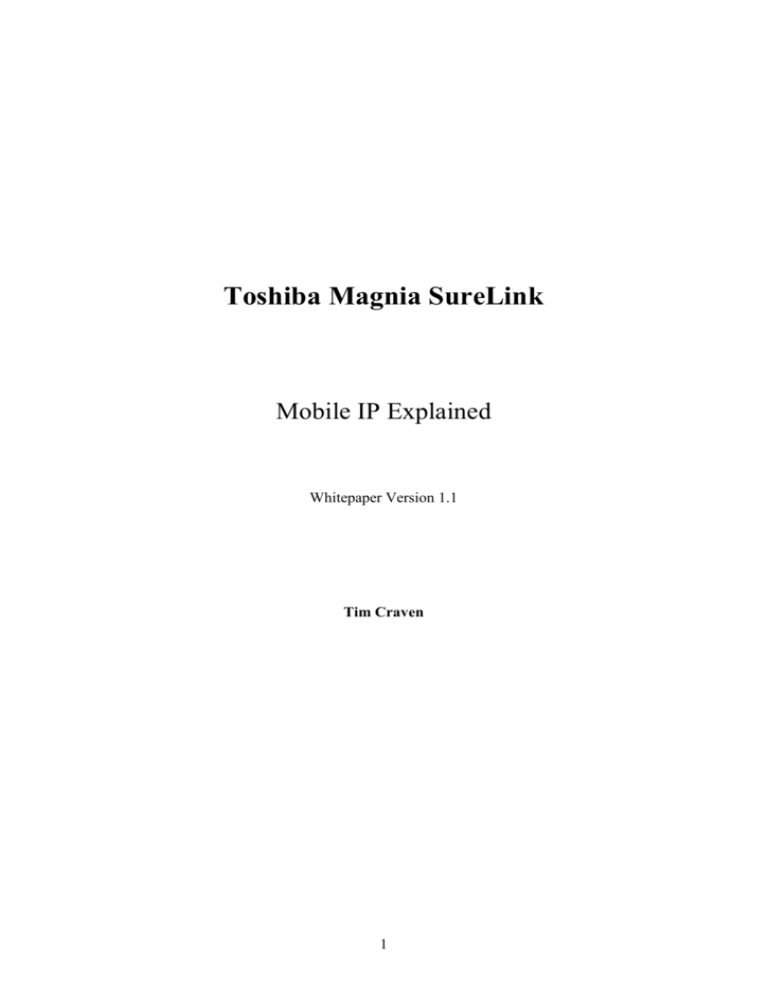
Toshiba Magnia SureLink Mobile IP Explained Whitepaper Version 1.1 Tim Craven 1 Table of Contents 1. Background 2. SureLink Mobile IP 3. A Practical Example 4. Independence of Network Type 5. Total Transparency to Applications 6. Ease of Deployment and Centralised Management 7. Flexible Security 8. Advanced Features – NAT Traversal 9. Supported Standards REASONABLE EFFORT IS MADE TO ENSURE ACCURACY OF THE INFORMATION CONTAINED WITHIN THIS DOCUMENT. THIS MANUAL AND ANY OTHER DOCUMENTATION DISTRIBUTED TO YOU AT ANY TIME IN CONNECTION WITH TOSHIBA PRODUCTS & SOLUTIONS ARE PROVIDED BY TOSHIBA "AS IS" WITHOUT WARRANTY, CONDITIONS OR OTHER TERMS OF ANY KIND, EITHER EXPRESSED OR IMPLIED, INCLUDING BUT NOT LIMITED TO, THE IMPLIED WARRANTIES OF MERCHANTABILITY, SATISFACTORY QUALITY, NON-INFRINGEMENT, AND FITNESS FOR A PARTICULAR PURPOSE. THE ENTIRE RISK AS TO THE ACCURACY AND COMPLETENESS OF THE DOCUMENTATION, IS WITH YOU. IN NO EVENT WILL TOSHIBA BE LIABLE TO YOU FOR ANY LOSS OR DAMAGES, WHETHER DIRECT OR INDIRECT, INCLUDING ANY GENERAL, SPECIAL, INCIDENTAL OR CONSEQUENTIAL, DAMAGES ARISING OUT OF OR IN CONNECTION WITH THE DOCUMENTATION OR ANY INFORMATION CONTAINED HEREIN OR THE USE THEREOF, OR ARISING OUT OF THE USE OR INABILITY TO USE THE PRODUCT OR SOLUTIION (INCLUDING BUT NOT LIMITED TO LOSS OF DATA OR DATA BEING RENDERED INACCURATE OR LOSSES SUSTAINED BY YOU OR THIRD PARTIES OR A FAILURE OF THE HOTSPOT TO OPERATE WITH ANY OTHER PROGRAMS), EVEN IF TOSHIBA HAS BEEN ADVISED OF THE POSSIBILITY OF SUCH LOSSES OR DAMAGES. ACKNOWLEDGEMENT TO SECGO GROUP OY 2 1. Background Internet capable devices have become increasingly mobile with the advent of laptops and PDAs with different wired and wireless Internet connections. However, the Internet protocol itself was not designed with such mobility in mind. Internet addresses are bound to the physical equipment that makes up the Internet, and are thus bound to physical locations. The problems pile up when an Internet device such as a laptop moves from one location to another, or switches from one network media to another. All ongoing Internet sessions and connections will break down as the device changes Internet address. The anticipated solution to the mobility problem is an Internet standard called Mobile IP. Mobile IP is standardised by the Internet Engineering Task Force (IETF), and has reached the status of a proposed standard. To realise the importance of Mobile IP as a standard, it should be noted that major players such as Cisco and Nokia endorse it. Mobile IP is also part of the CDMA2000 standard for third generation cellular networking. 2. SureLink Mobile IP The SureLink Mobile IP product is a complete solution for handling the Internet connections of a mobile device such as a Toshiba laptop. It is based on the Mobile IP standard, and is therefore compatible with software and hardware from other standard-supporting vendors such as Cisco. Mobile IP defines three components for managing the mobility of Internet devices: the Home Agent (HA), the Foreign Agent (FA) and the Mobile Node (MN). The Surelink Mobile IP product implements all three agents. The SureLink Mobile IP server takes care of the home agent and foreign agent functionality while the SureLink Mobile IP client takes care of the mobile node functionality. 3. A Practical Example As a practical example of Mobile IP operation, let us take a Z310 with the SureLink Mobile IP server, and a Tecra with the SureLink Mobile IP client. The Tecra is well equipped with Internet connection options. It has a built-in Ethernet NIC (Network Interface Card/Controller) and built-in WLAN NIC, Bluetooth, and PC Card expansion slots that can be used for cellular data connections, e.g. GPRS. The client's home network is the network where its server is located. In our example, the home network would be the Ethernet LAN. Any network other than the home network is called a foreign network. Examples of foreign networks in this example are: WLAN, an Ethernet LAN at a customer, a WLAN hotspot at a hotel or a GPRS connection. As long as the client stays in the home network the server plays a passive role, and the Internet operates normally in the same way as it would without Mobile IP. When moving to a foreign network, the client registers its new location with the server. All Internet traffic destined for the client will end up in the client's home network. However, after a successful registration, the server will start forwarding all data to the client's new location. While away, the client will also send all Internet traffic via the server to its final destination. 3 Example: The client Tecra is in its home network, connected to the Ethernet LAN. The user is downloading a PowerPoint presentation from the file server. As the client is in the home network, the IP traffic flows directly between the file server and the client without the Mobile IP server interfering. The user pulls out the Ethernet cable in order to move to a nearby meeting room. The Surelink Mobile IP client notices that the Ethernet LAN is not available anymore, and immediately finds the second best connection, the built-in WLAN NIC. The client registers its new location to the Mobile IP server. Now the Surelink Mobile IP server intercepts the traffic from the file server, and sends it on to the client. The client sends return traffic back to the server, which forwards it to the file server. The download continues without the user noticing any outage. The server function described above is what the Mobile IP standard calls a home agent. The Surelink Mobile IP server also supports the functionality of the foreign agent defined in the Mobile IP standard. The foreign agent operates in a foreign network, and offers Mobile IP services to clients visiting the network. It is an optional component in that it is not mandatory for proper operation. Examples of benefits achieved by using foreign agents are: The foreign agent provides the client with all necessary information to register its location in the network. Without a foreign agent the client needs to obtain an IP address (e.g. using DHCP) and it needs to find out what modes of operation are supported using a trial-and-error procedure. Increased performance: The extra work mentioned above takes time. With a foreign agent the time to switch networks (handover time) can be reduced to a fraction of the time it takes without a foreign agent. Increased scalability: In systems with many users, using foreign agents can reduce the load on the home agent and NAT gateways. Access control and accounting: The foreign agent can be used to control which clients have access to a network, e.g., it can grant network access in a meeting room WLAN to only employees, customers and partners. This part of the SureLink solution is based on the SG Series product and is referred to as the Branch Office server. 4. Independence of Network Type A user has WLAN, Ethernet and GPRS adapters in his Tecra laptop. He is connected to the Ethernet interface. Without SureLink Mobile IP, if he unplugs the Ethernet cable and starts using WLAN instead, all his open sessions will break. Applications may stop working or crash and lose important data, and the user possibly needs to log out and in again or even reboot the computer. With SureLink Mobile IP, the user can move freely between all network types with all sessions intact. The Surelink Mobile IP client will automatically select the best available network and ensure that the user is constantly connected. 4 5. Total Transparency to Applications SureLink Mobile IP works on the Internet protocol level, and is therefore totally transparent to Internet applications. Employing SureLink Mobile IP does not necessitate any configuration or other changes to existing applications. All applications become automatically mobile: WWW, e-mail, CRM, VoIP, fileshares, printing, calendar and collaboration tools such as netmeeting. 6. Ease of Deployment and Centralised Management Installation and management often present a surprisingly large portion of the total cost of the operation of a computer system. SureLink Mobile IP offers several features that ease deployment and provide for efficient management. The following includes some highlights of how these powerful features are employed together on the Toshiba: The Enterprise business model comprises of Mobile IP servers on both Z series and SG series servers. The Z310 hosts centralised management and remote configuration of clients, users and SG20 server via the Easy Admin service. The SureLink Mobile IP server can be configured to use LDAP or RADIUS services as user database backends. This makes it easy to integrate the Mobile IP service with an existing corporate user management infrastructure. User information is stored in one place only, which facilitates management and improves security. 7. Flexible Security Surelink Mobile IP does not place any artificial restrictions on the data security solution used to secure IP traffic. SureLink Mobile IP is designed to support all possible modes of VPN employment and to be compatible with all IPSec and other VPN products. This differentiates it from many other solutions that tie Mobile IP and VPN together in inflexible ways. Examples of how a decoupled solution can benefit the customer are: A corporation has made a large investment in an IPSec based VPN solution. It now wishes to offer mobility management services to its mobile laptop users. Buying a bundled product would imply replacing the existing IPSec infrastructure with the new product. The previous investment would then be lost, and expensive installation of new clients and servers would be required. Investing in SureLink Mobile IP would simply add Mobile IP support to the existing infrastructure. The existing IPSec clients and gateways would work without modification, thus saving money and installation work. SureLink Mobile IP can be combined with SureLink Crypto IP to support a vast number of different VPN employment models. As an example, other solutions often require the VPN gateway to be on the same machine as the Mobile IP server, which effectively hinders offering Mobile IP as a service. 5 8. Advanced Features: NAT Traversal SureLink Mobile IP follows closely the standards that define Mobile IP mobility management. Standards compliance is important, but it is not enough to ensure smooth and reliable mobile access in the diverse Internet of today. Surelink Mobile IP therefore offers several proprietary, advanced features that improve end-user experience and overall performance of the system, but without breaking compliance with the Mobile IP standard. One such feature is NAT traversal. Mobile IP access will not work if the client visits a network that uses NAT. With the NAT traversal option offered by SureLink Mobile IP clients and servers, access from a network behind a NAT is as transparent as from any other network. The following is a list of examples of networks from which standard Mobile IP access is not possible, but Surelink Mobile IP access is: 9. IKE: IPSec: GPRS networks in Europe Most WLAN hotspots The Ethernet and WLAN interfaces of the Magnia SG series Most consumer broadband services e.g. ADSL, cable modem, dial-up Supported Standards - AES/MD5 - AES/SHA1 - Blowfish/MD5 - Blowfish/SHA1 - CAST128/MD5 - CAST128/SHA1 - 3DES/MD5 - 3DES/SHA1 - DES/MD5 - DES/SHA1 (used) - AES/MD5-96 - AES/SHA1-96 - Blowfish/MD5-96 - Blowfish/SHA1-96 - CAST128/MD5-96 - CAST128/SHA1-96 - 3DES/MD5-96 - 3DES/SHA1-96 - DES/MD5-96 - DES/SHA1-96 (used) 6
